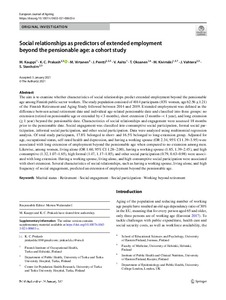Social relationships as predictors of extended employment beyond the pensionable age: a cohort study
Kauppi M; Prakash KC; Virtanen M; Pentti J; Aalto V; Oksanen T; Kivimäki M; Vahtera J; Stenholm S
Social relationships as predictors of extended employment beyond the pensionable age: a cohort study
Kauppi M
Prakash KC
Virtanen M
Pentti J
Aalto V
Oksanen T
Kivimäki M
Vahtera J
Stenholm S
SPRINGER
Julkaisun pysyvä osoite on:
https://urn.fi/URN:NBN:fi-fe2021042824892
https://urn.fi/URN:NBN:fi-fe2021042824892
Tiivistelmä
The aim is to examine whether characteristics of social relationships predict extended employment beyond the pensionable age among Finnish public sector workers. The study population consisted of 4014 participants (83% women, age 62.56 +/- 1.21) of the Finnish Retirement and Aging Study followed between 2014 and 2019. Extended employment was defined as the difference between actual retirement date and individual age-related pensionable date and classified into three groups: no extension (retired on pensionable age or extended by < 3 months), short extension (3 months-< 1 year), and long extension (>= 1 year) beyond the pensionable date. Characteristics of social relationships and engagement were assessed 18 months prior to the pensionable date. Social engagement was classified into consumptive social participation, formal social participation, informal social participation, and other social participation. Data were analyzed using multinomial regression analysis. Of total study participants, 17.8% belonged to short- and 16.5% belonged to long-extension group. Adjusted for age, occupational status, self-rated health and depression, and having a working spouse (OR 2.34, 95% CI 1.39-3.95) were associated with long extension of employment beyond the pensionable age when compared to no extension among men. Likewise, among women, living alone (OR 1.60, 95% CI 1.28-2.00), having a working spouse (1.85, 1.39-2.45), and high consumptive (1.32, 1.07-1.65), high formal (1.47, 1.17-1.85), and other social participation (0.79, 0.63-0.98) were associated with long extension. Having a working spouse, living alone, and high consumptive social participation were associated with short extension. Several characteristics of social relationships, such as having a working spouse, living alone, and high frequency of social engagement, predicted an extension of employment beyond the pensionable age.
Kokoelmat
- Rinnakkaistallenteet [27094]
